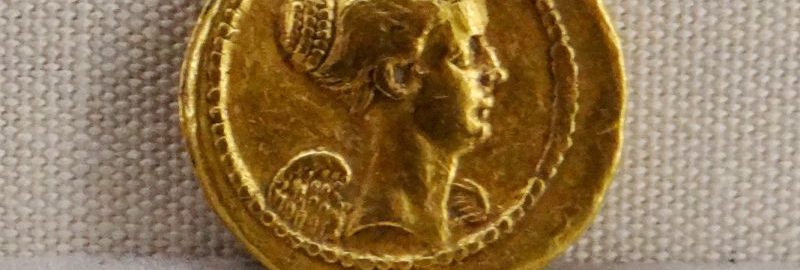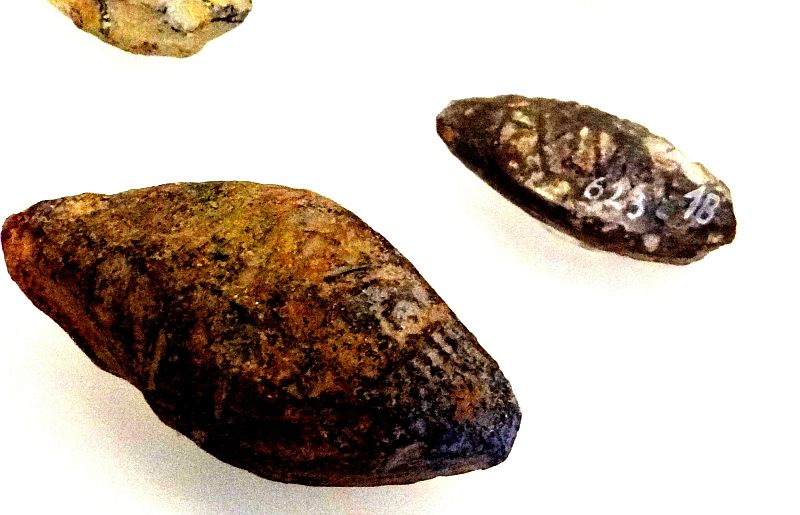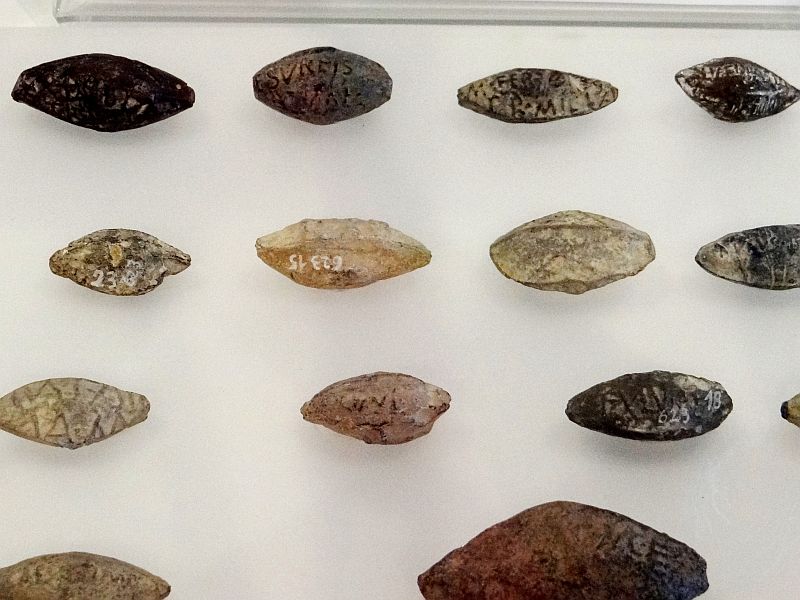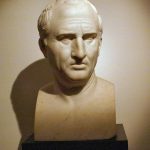Fulvia was the daughter of Marcus Fulwius Bambalio and Sempronia Tuditani. The father was called Bambalio, which meant Stutter. Marcus Tullius Cicero called him “a good man”, but he probably did not achieve much on the political scene. About his maternal grandfather, Sempronius Tuditanus, Cicero in turn said that he was a madman who threw money out of rostra to the poor.
Was it madness or rather charity, one might wonder? It is not known whether or to what extent the ancestors were related to the Sempronius Grakch family, brothers Gaius and Tiberius, or Marcus Fulwius Flakkus, who were known for their activities for the benefit of the town commoners. Certainly, it was not thanks to the relationship with the Grakchs that the family was wealthy – the Grakchs, as traitors to the republic, were probably deprived of their property.
She might have been born in the 80s of the 1st century BCE. At that time, her mother was married to Marcus Fulvius. Her aunt may have been Sempronia, known from the trial of the conspiracy of Sergius Catilina. Then Fulvia would be the cousin of Decimus Junius Brutus Albinus, Caesar’s legate in the wars in Gaul, as well as one of his assassins. If so, the women in her family were distinguished not only by their beauty and personal charm, such as the aforementioned Sempronia, who “could sing and dance better than a woman from her sphere would be expected to do so”, but also by political fervour. Fulvia was ambitious and politically committed for sure. Like some other women of her time, she let herself be remembered. It was then that women appeared in public life more and more often, so often that laws tried to silence them.
She married for the first time Publius Claudius Pulcher, the distant great-grandson of Appius, builder of the Via Appia. Pulcher came from an ancient and wealthy patrician lineage. When he was going to become a plebeian tribune, he decided to change the regulations governing it, but when it was unsuccessful, he allowed the plebeian family to adopt him, changing his name to Clodius. His political activity was aimed at helping the urban poor and violated the interests of the patricians and the wealthy. Clodius was killed in January 52 BCE when he ran for the consulate in a not entirely accidental clash with the men of Annius Milo supported by Gnaeus Pompey on the same Via Appia, that was built by his great-grandfather. Fulvia and his men carried his body to the Curia – the place of Senate meetings at the Forum Romanum. There the people decided to burn his body. The building burned down and since then the meetings have been moved to the Pompey Theater. The defence of Annius Milo was undertaken by Cicero, which only deepened the earlier conflicts with Fulvia. The riots spread so much that Milo fled the trial.
The next husband was Gaius Scrbonius Curio. He was known, among other things, for the fact that he was the first to combine two theatres on a semicircle plan, creating the first amphitheatre, when organizing the games. The Kurio, like Pulcher, was an acquaintance of Marcus Antony. He died on the Bagrades River in Numidia, Tunisia, in 49 BCE, when the locals poisoned the river, forcing their troops to retreat into the mountains. Both husbands are considered to be Caesar’s allies, although history shows that things were different.
The third husband was a well-known ally of Caesar. He is Mark Antony himself. There is no evidence of when they finally got married, but they had a lot in common even before that. It may have been at the beginning of 46 BCE. It cannot be ruled out that Fulvia owned a property that benefited her husband, but it must be taken into account that the Pulcher and Curia families were wealthy and Antony made a fortune in Gaul.
After the murder of Gaius Julius Caesar, in 44 BCE, Marcus Antony and Fulvia tried to control the chaos in Rome. It is possible that the excess of laws that were “happily found” after Caesar’s death arose with both of them. Such an accusation throws Cicero. Fulvia certainly played a role in the case of the king of Galatia, Deiotar, who, by favouring the Pompeians, exposed himself to Caesar. In exchange for a large sum, Antony was to restore him to the throne. That is why Cicero accused her and Antony of dealing with state matters in gynecum (women’s room in Greek houses).
It was remembered thanks to the messages of its opponents. Cicero accuses her of greed. Given that Fulvia took over the city clubs and mercantile societies that favoured Clodius, she might have needed money to support a large number of clienteli – dependent poorer townspeople and armed groups. It was written about her that she had nothing feminine except her body, that she carried a sword behind Pulcher, and that she brought her husbands, in short, bad luck. Suetonius adds that she had some irregularity in the features of her face. However, this did not prevent her from binding Marcus Antony to herself. During the time they were married, he climbed to the heights of politics. Plutarch wrote about her, she did not intend to sit at home and spin, but to rule over her imperious husband.
When Octavian fought Antony at Mutina in 43 BCE, Fulvia and his mother “going door to door” tried to get the senators not to declare him a public enemy. When they finally reconciled, before the Battle of Philippi, she was actively raising funds for the war in 42 CE. When wealthy women were taxed, Fulvia refused those who demanded the abolition of unfair laws.
It should be added that perhaps it was also behind the proscriptions resulting from the Second Triumvirate for some people. She was certainly pleased with the death of Cicero. The disputes with Cicero over the years over his conflict with Pulcher and their mutual accusations, and finally the death of her beloved husband, made her genuinely hate him. One account says that when Cicero’s head was brought, Fulvia supposedly pierced his tongue with a hairpin.
So why did such a woman escape the nooks and crannies of history?
This explains another remark from Plutarch, who said that Cleopatra owed her gratitude for having trained a domineering husband to female power. Unfortunately, Antony’s romance with the queen overshadowed the character of Fulvia a bit. After the Battle of Philippi, the victorious Marcus Antony, while dealing with the eastern provinces, was caught in the queen’s trap for good. During this time, Fulvia had to deal with Antony’s remaining allies in Rome, and the growing influence of the young Octavian. He was rewarding his veterans with the land.
By this time Fulvia was Octavian’s mother-in-law. After concluding the 2nd Triumvirate with Mark Antony and Marcus Lepidus, he married her young daughter Clodia. The conflict grew until Octavian sent Clody “intact”. His daughter’s rejection met with a reaction, the more so as Antony’s veterans felt more and more forgotten. At that time, the city praetor was the youngest brother of Mark Antony, Lucius Antony. Together with Lucius, Fulvia officially took the stand against Octavian. They kept Octavian and Rome in check for a while. Perhaps Fulvia’s intention was to provoke Antony to return. There were rumours that he had tied up with Glafira, the queen of Cappadocia, who was married to the son of his friend Archelaos, who died in Egypt, as it may be assumed a little younger. At that time, news about Cleopatra had not yet reached Rome.
Finally Fulvia and Lucius went to Etruria and were besieged in Perusia. The city surrendered when Octavian cut off food and supplies in the winter of 41 BCE to 40 BCE. Octavian allowed Fulvia to leave Italy. Lucius Antony was officially supposed to go to Spain, but he may have been murdered, as we will not find any more news about him from now on.
Fulvia went to Greece. Antony found her in the city of Sicyon. When he found out what was happening in Italy while in Egypt, he decided to return to Rome. The meeting was supposed to end with a brawl. Antony probably grew angry at the news of the lost war and his wife’s commitment. As reported by historians, Fulvia soon “happily” died of grief and sudden illness. It was in the summer of 40 BCE.
As a sign of peace, Antony married Octavia, Octavian’s sister. Although Fulvia has been accused of all sorts of things, this is probably due to the fact that she entered the territory assigned to men, she took up politics. Her conduct was clearly against the established rules. However, the accounts prove that she was an exemplary, faithful and loyal wife to all her husbands.
She had two children with Publius Clodius Pulcher, Clodius and Clodia, Octavian’s first wife. Scribonia also gave birth to a son. With Marcus Antony, she had two sons, Marcus Antony known as Antyllus and Jullus. Antillus can be shortened from Antonillus, little Antony, or it can mean archer – antillus. This was also the name of one of the allies of the Gracchi brothers, Antyllus, who accompanied Antony in Egypt, and was strangled by Octavian in Alexandria. However, it was Jullus who would spoil his blood in the future. For Jullus was having an affair with Octavian’s daughter, Julia. Researchers believe it was more of a conspiracy than an affair.
In the Museum in Perugia, you can still see specific slingshot balls with vulgar inscriptions directed against Fulvia by Octavian’s soldiers. The coin collections also include denarii after 42, after the Battle of Philippi, when Antony defeated Marcus Junius Brutus and Cassius Longinus. They show an image of a woman with a characteristic hairstyle and wings. Researchers argue that it may be an image of Fulvia personifying Nike, the goddess of victory. Then Fulvia is the first Roman woman whose image was on a Roman coin during her lifetime.











